The Apple iPhone 6s and iPhone 6s Plus Review
by Ryan Smith & Joshua Ho on November 2, 2015 8:00 AM EST- Posted in
- Smartphones
- Apple
- Mobile
- SoCs
- iPhone 6s
- iPhone 6s Plus
Battery Life
With any smartphone, battery life is always one of the most important considerations. It probably goes without saying that more battery life is always better. In the case of the iPhone 6s, battery life is especially important to examine because this year Apple has actually made the battery of their phone smaller than before. Normally, it’s almost a given that battery size will be at least constant or increase but in order to accommodate additional components like the Taptic engine the battery has been made smaller. In light of this reversal one might assume that battery life has decreased as a result, but given the move to a FinFET process and other major component improvements it’s hard to say how battery life has increased or decreased. In order to test this properly, we ran the iPhone 6s’ through our suite of battery life tests to try and get an idea for overall battery life. As always, we run all battery life tests with the display set to an average of 200 nits and all possible background tasks disabled.
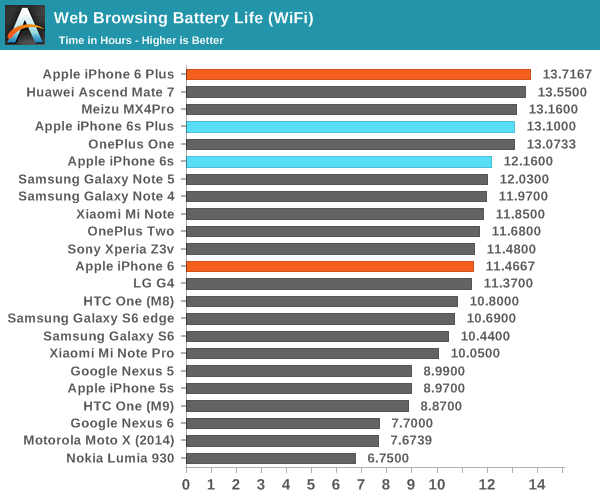
Our first test is WiFi web browsing, and here we see a pretty curious trend. The iPhone 6s Plus appears to regress relative to the iPhone 6 Plus, yet the iPhone 6s solidly beats the iPhone 6. I was pretty confused by this, but it’s likely that we’re seeing these results because the iPhone 6s is going to have larger relative power consumption of the SoC when compared to the display. As the display becomes bigger, the effects of SoC efficiency are just harder to notice, which also explains why it looks like the iPad Air 2 has effectively the same battery life whether you’re running just a blank display or our web browsing test. Both of our review units use a TSMC A9, so I don’t think we can attribute a foundry difference to the odd results that we’re seeing here.
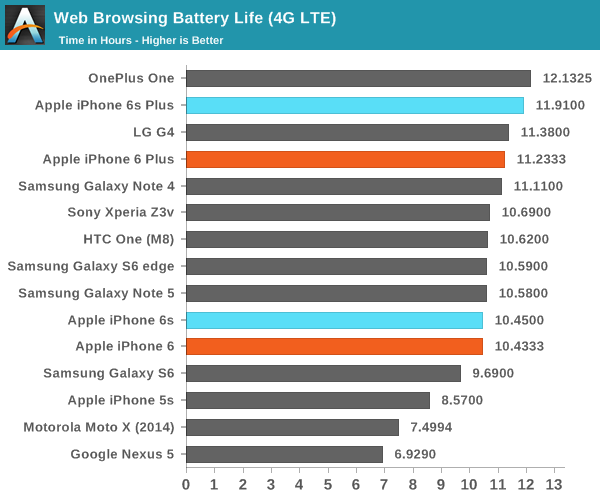
In LTE web browsing, we see a smaller improvement than what we observed in the WiFi test. This might seem strange, but given that the move from a 28nm process to a 20nm process on the modem from iPhone 6 to 6s didn’t come with FinFET it makes sense that the modem will remain a significant power drain. It’s likely that the next big jump in battery life here will come with FinFET process technology on the modem, along with other general modem design improvements.
In order to also look at battery life in more extreme scenarios, we use Basemark OS II and GFXBench to really place a strong stress on the CPU and GPU to see what power draw is like under sustained load. This also allows us to see the extent to which various components of the phone throttle down in response to relatively high sustained loads. However, it’s important to note that the Basemark OS II performance score here isn’t necessarily as accurate as scores from Android devices as the battery score can be calculated with 98 data points instead of 80 as battery score is partially derived from the rate at which the battery percentage decreases. It's also worth noting that in GFXBench there are two data points removed as the low power popup causes an incorrect frame rate to be recorded.
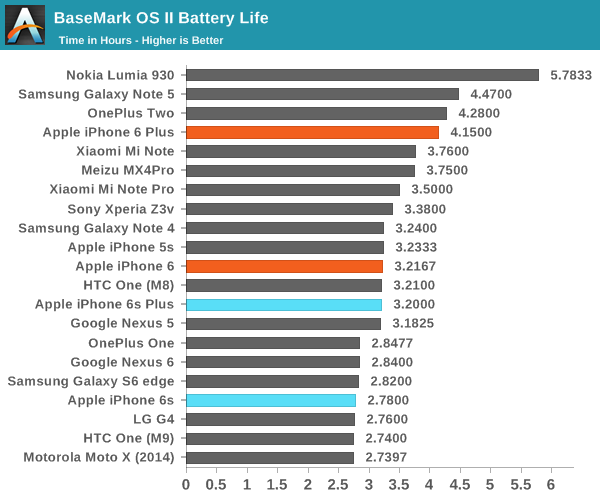
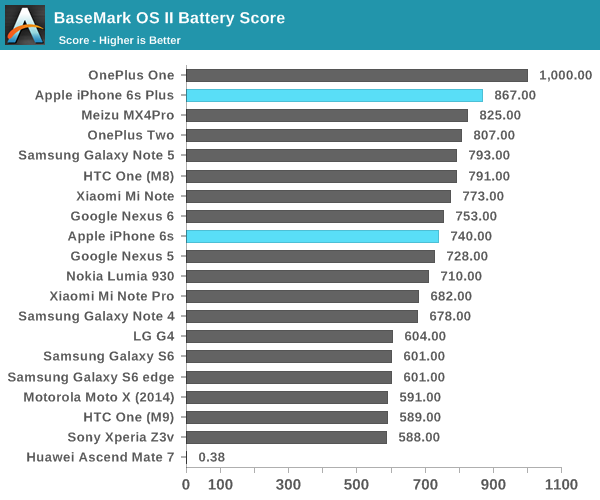
In Basemark OS II, we start off with a pretty shocking result as the iPhone 6s lasts less than three hours in this test, but looking at the battery score it’s pretty clear that the reason why the iPhone 6s doesn't last very long is because it’s running with relatively little throttling throughout the test, so the battery score is high as a result. The same is true of the iPhone 6s Plus, but the larger battery helps it to last a bit longer.
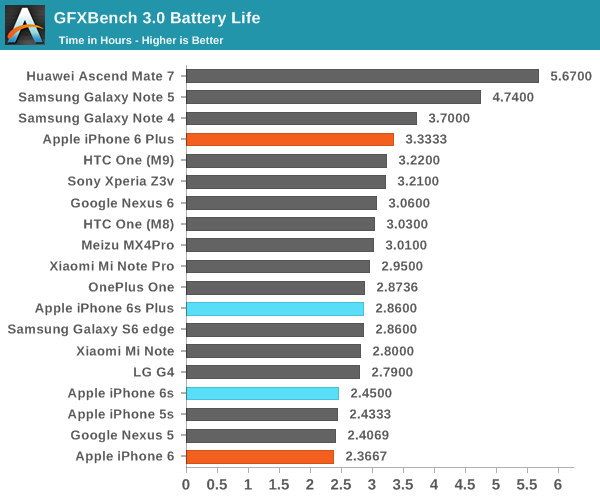
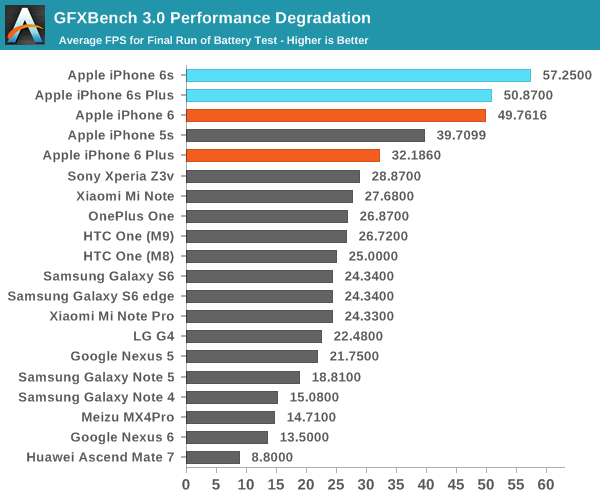
Looking at GFXBench, which is an infinite loop of the T-Rex on-screen benchmark to approximate intensive video gaming we see that the iPhone 6s doesn’t last very long either, but the performance throughout the test is incredible. Due to 1334x750 display resolution and strong GPU, the iPhone 6s manages to last the entire test without any notable throttling, and effectively pegged at the refresh rate of the display. The iPhone 6s Plus manages a similar level of performance but over time you can start to see some throttling, likely a function of the longer runtime and higher display resolution. It’s interesting to see how in the space of two years just how much progress has been made here in terms of improving GPU performance and efficiency, as when we first ran this test it was probably one of the most stressful tests out there for any smartphone or tablet.
Charge Time
Of course, while battery life is usually the main determinant of overall mobility it’s often important to consider charge time. A phone that charges slowly can be much less mobile than another phone, even if it has better battery life. In the case of the iPhone 6s’, it seems that Apple continues to ship the standard 5W charger that they have for many generations in the smartphone industry. In order to see how this charger and phone combination performs, we use our usual methods of timing the phone from fully discharged to fully charged.
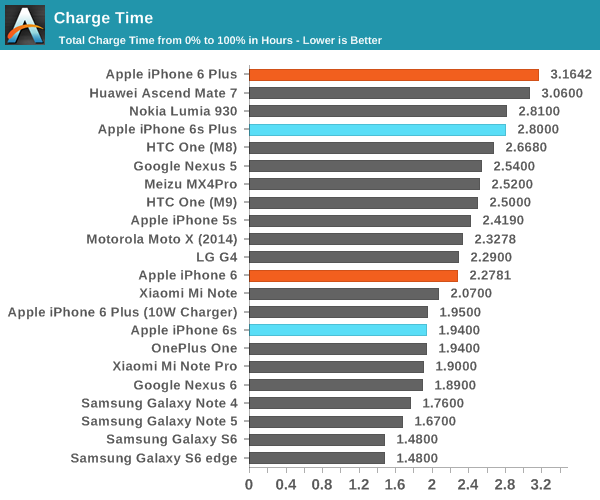
Here, the iPhone 6s and 6s Plus both show a decent improvement over the iPhone 6 and 6 Plus, but not enough to make an significant difference. The iPhone 6s charges at a pretty reasonable rate, but the iPhone 6s Plus really does need a more powerful charger than it does now. You can use an iPad charger to bring things back up to speed but getting this means that you either have to have an iPad already or you have to go out and buy an iPad charger, which is on the annoying side when Android OEMs generally include fast chargers in the box.




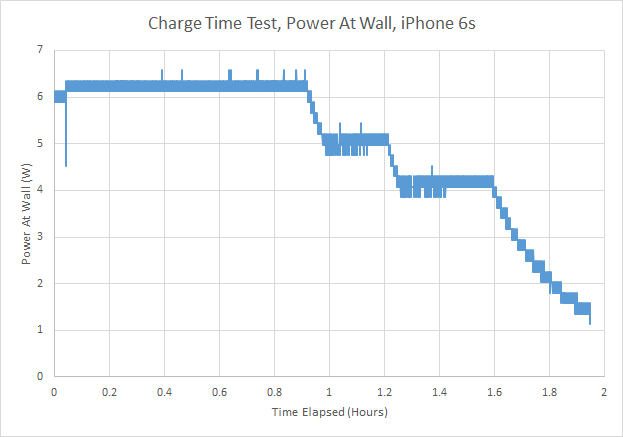
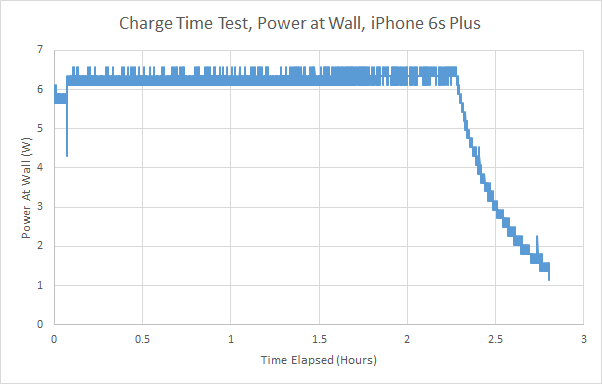








531 Comments
View All Comments
blackcrayon - Monday, November 2, 2015 - link
I bet it goes further than you think. I bet Anandtech is paying Huawei and Samsung or maybe has undercover agents at Qualcomm to make sure their SOCs perform more slowly than Apple's. It's the only way to explain it!You're so enraged and deluded that you can't see how something that is pretty much universally agreed as "one of the best" could possible be "the best" in someone's opinion (an opinion backed up by a uniquely large amount of test data I should add).
osxandwindows - Monday, November 2, 2015 - link
You and your conspiracy theories.lol
So what other conspiracy theories do you have about anandtech
blackcrayon - Wednesday, November 4, 2015 - link
Maybe Apple injected code into Webkit (that's also in Chrome and that Microsoft and Mozilla also copied unbeknownst to them) that makes any bar graph showing iPhone performance to have longer lines! Except when smaller lines are better, then it makes them shorter. :)melgross - Monday, November 2, 2015 - link
Maybe because it actually is the best, despite what Android users want to think.zeeBomb - Monday, November 2, 2015 - link
the fight between android and apple will never end.itpromike - Monday, November 2, 2015 - link
Paid? That is a very dangerous and very serious accusation for a publication such as Anandtech which does scientific and objective chip architectural analysis as well as benchmarks and performance measurements. You are suggesting that Apple is literally giving them money to lie to all of their readers and to willingly change benchmark results AND architectural analysis, including forging SOC cross section pictures (also implicating chip works of being equally fraudulent and deceitful)? You are truly saying that Apple is paying Anandtech to publish falsified results, with Anandtech having no integrity at all? WOW. That is a BOLD BOLD claim. I'd love to see your journalistic proof of this. Do you have links to bank statements, written contracts, emails, phone conversation recordings, etc... that we all can look at so we can make sure the public is aware that Anandtech writers, and analysts are liars? Or can you share with us your deep examination and analysis of the page by page writings and findings in the review in contrast to your on findings that you've spent hours on end testing and analyzing? This way none of their readers will mistake them for being an honest, data driven publication. Just go ahead and link to your findings in the reply to this message. ThanksAlexey291 - Tuesday, November 3, 2015 - link
Er are you sure you're not confusing anandtech from half a dozen years ago with a marketing publication with the same name in the now?shadowii - Monday, November 2, 2015 - link
Wow, what a worthless reply. Read the article.KoolAidMan1 - Monday, November 2, 2015 - link
Anandtech backed up their conclusion with pages and pages of objective tests and analysis. This bothers you so you accuse them of being paid shills.Standard Fandroid in the wild, ladies and gentlemen.
Ethos Evoss - Monday, November 2, 2015 - link
Yeah and final words section like wtitting a bokk !!! Fkin never seen end so long like this..The whole review - aplle bible.. anandtech had to follow apples bible......